9

THE MUSICAL UNIVERSE
THE REVIVAL OF THE ANCIENT PRACTICE of arranging phenomena in systems of correspondence can contribute much to our understanding of the world. The idea that seemingly separate things in different scales and modes of being are related to one another resonates deeply with the human soul that hungers for a meaningful vision of the world in which things are connected in ways that are simple and understandable. An example of a correspondence structure that gives a sense of this idea is shown in drawing 9.1. Here the relation of diverse phenomena draws forth a deeper understanding of the unity that joins different cycles of nature and of human life. Its purpose is simplification and understanding. The words are combined within a geometric matrix and are joined by implied proportional expressions, for example,
spring : childhood :: winter : old age.
The elements are connected through the mechanism of correspondence that arises from a relational harmony that permeates the Universe.
AS ABOVE, SO BELOW
The ancient theory of correspondence is now being revived as an alternative to a reductive science that finds itself increasingly unable to explain the world in terms understandable to the majority of people. Physicist Richard Feynmann wrote:
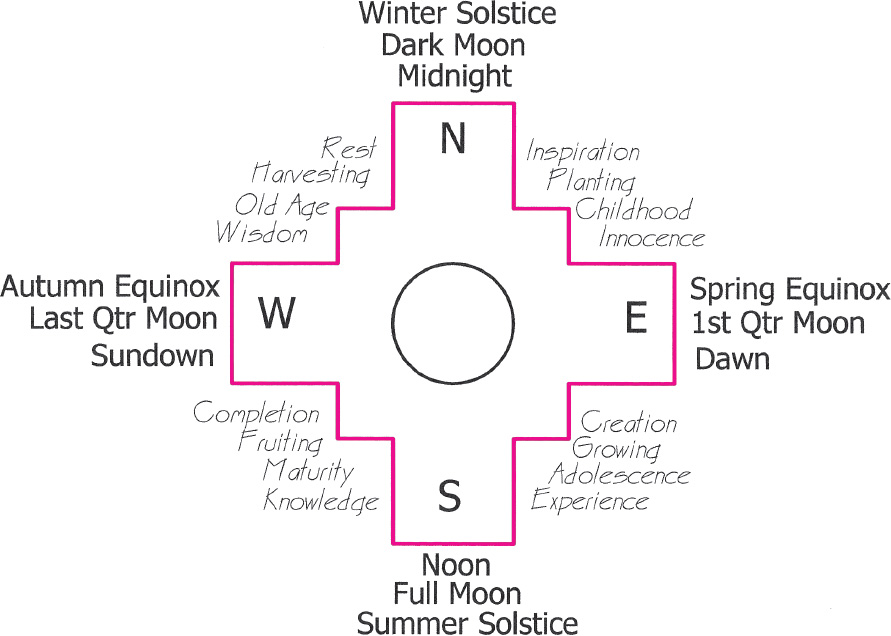
Drawing 9.1. An example of a correspondence diagram demonstrating the relation of plant and human growth and the lunar and solar cycles.
It always bothers me that, according to the laws as we understand them today, it takes a computing machine an infinite number of logical operations to figure out what goes on in no matter how tiny a region of space, and no matter how tiny a region of time. How can all that be going on in that tiny space? Why should it take an infinite amount of logic to figure out what one tiny piece of space/time is going to do?1
This is an example of how we can get so involved in explaining the details that we miss the whole—how we can’t see the forest for the trees. Correspondence in the context of harmonic science offers an alternative way of understanding the world as a whole, just as holistic medicine offers an alternative, not a replacement, for allopathic medicine.
Systems of correspondences were an important part of ancient sacred science that emerged naturally from the perceptions of similar patterns at different levels of being. Such self-similarity is a characteristic of, for example, the ever-smaller branching patterns in blood vessels, in plant branching, and in river systems. Thus arteries and capillaries of animals correspond in form and in function to the patterns created by main channels and streams of river systems. The principle that is elucidated is liquid flow, which also corresponds to nonmaterial processes such as the many streams of thought, memory, dreams, and so forth, that feed into the river of creative work. We begin to see that correspondence is often expressed through metaphor, the language of poetry and myth. In the mythic vision our life becomes a meaningful journey filled with synchronicities and magical initiations rather than a series of random events.
*
There was a desire among the ancients to validate their metaphorical insights with exact knowledge—that is, to find numerical correspondences that could support their findings. In this book we have explored some of these numerical-physical correspondences using, for the most part, the numbers of the musical scale and the numbers derived from the golden section.
The inverse correspondences between the movements of the sun and the moon are interesting. In midwinter when the Sun is low in the sky and its light is at its weakest, the Moon is at its highest in the sky and shines the brightest. This is reversed in midsummer. At the summer solstice the Sun and Moon set in opposite locations, the Sun north of west and the Moon south of west. This is reversed in midwinter. At the equinoxes the Sun and Moon set at the same points.
There is a harmony and a dance between the two. One lights up the night most brightly at the darkest time of year. One lights the days the longest while the other dims her light. Just as with the tides in which the work is shared, the task of lighting the world is harmoniously divided between the two luminaries. These mysterious goings-on in the sky led the megalith builders to erect observatories so that they might better understand the principles at work. The numerical knowledge that resulted became the foundation of ancient sacred science, so called because the events in the sky were considered to be the workings of the gods.
*
The use of musical numbers to describe celestial events seems appropriate in a universe where harmony and dissonance are ever-present realities. The interval of unison is considered the highest harmony, and the exact unison of the sizes of the Sun and Moon in the sky is a significant message to us about the relationship of the two that, for the majority of ancient civilizations, have represented the masculine and feminine principles. They share their duties according to their powers. The Sun dispenses the greater light while the Moon provides the greater pull on the waters. While they appear to be the same size in the sky, their diameters are in the ratio of exactly 400 to 1. The sizes of their diameters expressed in the harmonic numeration of the imperial system are 864,000 miles and 2,160 miles. Their essential numbers are thus 864 and 216, which are in double-octave relation using the doubling system of octave calculation. Thus the octave from 128 to 256 contains the 216 tone at the Pythagorean-sixth interval (16/27). Similarly, 864 is at the Pythagorean sixth in the octave 512 to 1,024. The central 256–512 octave lies between them.
Furthermore, we have seen in chapter 2 how the yearly cycles of Earth and Moon are related by 20/ϕ and how the diameter ratio of Earth/Moon is 3.66, which corresponds to the temporal measure of 366 revolutions of Earth during its 365-day journey around the Sun. We mention these again in order to emphasize that the beautifully choreographed dance of Sun, Moon, and Earth has a foundation in numerical correspondences, which are universal in scope, a fact that will become apparent in the final chapters of this book.
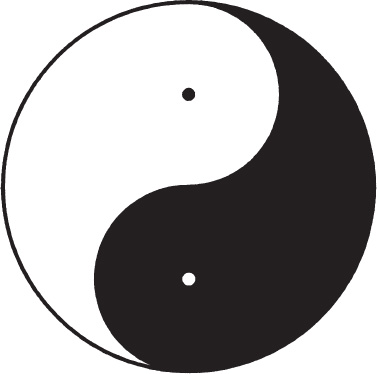
Figure 9A. The taiji, or yin-yang, symbol is an expression of the principle of correspondence that manifests as reciprocation, inversion, complementarity, resonance, and reflection.
THE WATER OF LIFE
Leonora Leet in the Secret Doctrine of the Kabbalah writes about the correspondence between the biblical days of Creation and musical intervals. For example, the third day of Creation in which dry land, or “earth,” is created is associated with the interval of the fifth. Leet then shows how the fifth day of Creation, in which “creatures inhabiting the flowing elements of water and air” are created, corresponds to the major-third interval.
The fifth interval, as we have seen, is associated with the third harmonic and the third with the fifth harmonic. The interval of the fifth also generates the vesica piscis, whose internal angle between poles and equator ends is 120 degrees, an angle from which a hexagon can be constructed. The hexagon in this Creation scenario is the first form to be differentiated from the circle, the original form symbolizing the fundamental tone. The hexagon emanates from the circle as spontaneously as a hexagonal snowflake takes shape from its dust mote seed, or as the interval of the fifth arises from the singing voice. The radius of the circle becomes the sides of the hexagon whose vertices are located with six equal gestures with the compass. The fifth, the first tone after the fundamental, can be said to correspond to the element of earth, the biblical “land,” the symbol for nonorganic matter. The “waters” are created from the major-third interval whose generating vesica has an internal angle of 104.5 degrees (drawing 4.18), the bond angle of the water molecule.
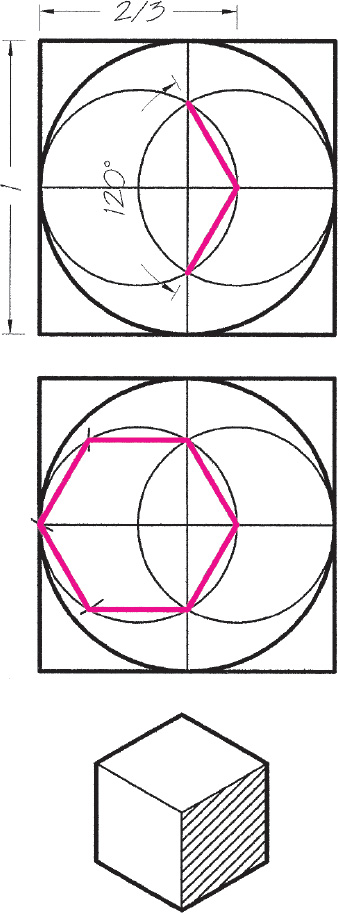
Drawing 9.2. In the top drawing the vesica piscis generated from the musical interval of the fifth (see drawing 1.4) contains the first two sides of the hexagon. In the middle drawing the length of a hexagon side is stepped around the circle to complete the hexagon. In the bottom drawing the outline of the hexagon is shaded, resulting in a three-dimensional representation of a cube, the Greek symbol for the element of earth.
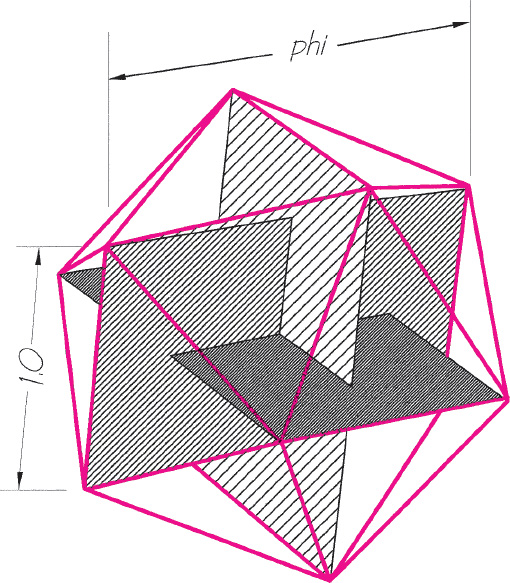
Drawing 9.3. The icosahedron, the water symbol of the ancient Greeks, has an internal structure consisting of three intersecting ϕ rectangles.
According to Leet the fundamental is associated with the first day. She writes that “the first day can be associated with heaven,” which combined with the land (the fifth) of the third day and water (the third) of the fifth day, produces a major chord containing the essential elements of a living creation: spirit, water, and land. From this harmonious beginning the song of Creation can proceed.
With water there are other correspondences—to both 5 and ϕ. We recall the diagonal construction that locates the major third on the musical string (chapter 1) in which the crossing of two half-square diagonals locates the 4/5 third node on the string. The half-square diagonal is the generator of ϕ, which itself has an affinity with the number 5 both through the pentagon and the √5—that is,
(√ 5 + 1) ÷ 2 = ϕ.
The Greeks assigned the symbol for water to the icosahedron with its twenty equilateral triangular sides. Twenty and its first few multiples and divisors all reduce, through octaves, to 4/5 (.80), the major third—1.25, 2.5, 5, 10, 20, 40, 80, 160:
1 ÷ 2.5 = .4 and .4 × 2 = .80,
1/20 = .05 and .05 × 2 × 2 × 2 × 2 = .80,
1/80 = .0125 and .0125 × 2 × 2 × 2 × 2 × 2 × 2 × 2 = .80, and so on.
The twenty triangular sides of the icosahedron join to form twelve intersecting pentagons, which again emphasizes the theme of 5, the number of the third, and of ϕ. And the inner structure of the icosahedron consists of three intersecting ϕ rectangles (drawing 9.3).
“Earth” for the Greeks corresponded to the cube with its six faces recalling the six sides of the hexagon—from which an isometric cube can be drawn (drawing 9.2). The association of water with the number 5 and the pentagon shows its affinity with ϕ and its relation to life-forms such as flowers, which frequently have a pentagonal pattern, and to those plants such as sunflowers that incorporate the ϕ-based Fibonacci series in their seedhead patterns. The major-third interval gives “life” to the primal scale of the fundamental and the fifth as water joined with the mineral matter of Earth gives life to the buried seed.
THE GREAT CENTRAL SUN
In esoteric lore there exists another sun around which our Sun orbits. This is the Great Central Sun (GCS), an entity of transcendent power. It has been considered variously to be Alcyone, a star in the Pleiades cluster, as well as the star Sirius. Others hold that it is a spiritual energy that resides within us. Some believe that the GCS is at the center of our Milky Way galaxy, a region whose mass is four million times that of our Sun and is the site of a supermassive black hole. We can affirm that our Sun and all the other stars in our galaxy orbit around this region and thus, if there is such an entity as the GCS, this would be a good place for it.
We may find more clues to the idea of the Great Central Sun in ancient number lore. Let us hypothesize that this GCS is indeed located at the Galactic Center and that it is the source of cosmic energies that radiate into our galaxy. There is a number in numerology that seems to describe the effects of the GCS, and that is the number 3,168, one of the most sacred numbers of gematria. John Michell describes it this way:
The general character of the number 3,168, as conveyed by its position in ancient cosmological diagrams and the phrases associated with it through gematria, is that it represents the spirit which passes through and encircles the universe, Plato’s world soul. The Christian term for this spirit, developed from the number 3,168, was Lord Jesus Christ. . . . The pre-Christian reference of this number seems to have been to the twelve gods of the zodiac.2
The symbolic number 3,168, which we will now identify with the Great Central Sun, happens to be in relation to the Sun-diameter number as the Earth-diameter number is to the Moon-diameter number. Using the Sun (864), Earth (792), and Moon (216) numbers as previously established we have
3,168/864 = 792/216 = 11/3 or 3.666
(366 being the number of yearly revolutions of the Earth).
The important synchronicity here is the Earth/Moon diameter ratio has the same essential numbers as that of the yearly revolutions of Earth. This very number becomes a symbol relating the GCS to the Sun and thus connecting us by means of number to the Galactic Center.
It also happens that 3,168 is in major-third relation (the water tone) to the Earth number:
7,920 × 2/5 (octave third) = 3,168.
This could tell us that Earth baptized by cosmic water (carried by the primordial rain of water-bearing meteorites and comets onto Earth) attains life and consciousness.
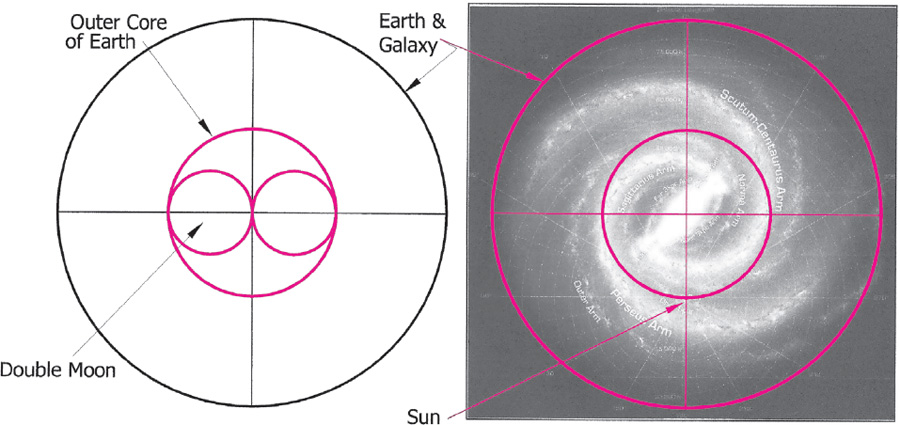
Drawing 9.4. On the left is a drawing of Earth with its outer core, whose diameter is 4,320 miles, which is equal to 2 × 2,160 miles, or twice the Moon diameter. In decimal terms the Moon diameter is .272 x the Earth diameter, which here is equal to 1. If we expand the Earth circle to the size of the galaxy (pictured in an artist’s conception on the right), estimated as 100,000 light-years in diameter, then the Moon circle would equal 27,200 light-years in diameter, which happens to be the estimated distance of the solar system to the galactic center. The scaling-up of the outer-core circle of Earth, consisting of a doubled Moon, then represents the ideal circular orbit of the solar system around the Galactic Center. We have placed this outer core/ orbit circle in the center of the galaxy. The position of the Sun and its solar system is shown by the arrow pointing to the orbital circle. In this we have continued with our correspondence practice as a means of bringing the heavenly down to earth, in this case, literally. The intention is not to make scientific claims but rather to open our minds to the possibility that universal correspondence may exist among different levels of reality as the ancients believed.
“Behold, reader, the invention and substance of this little book! In memory of the event I am writing down for you the sentence in the words from that moment of conception: ‘The Earth’s orbit is the measure of all things.’”
JOHANNES KEPLER FROM MYSTERIUM COSMOGRAPHICUM3
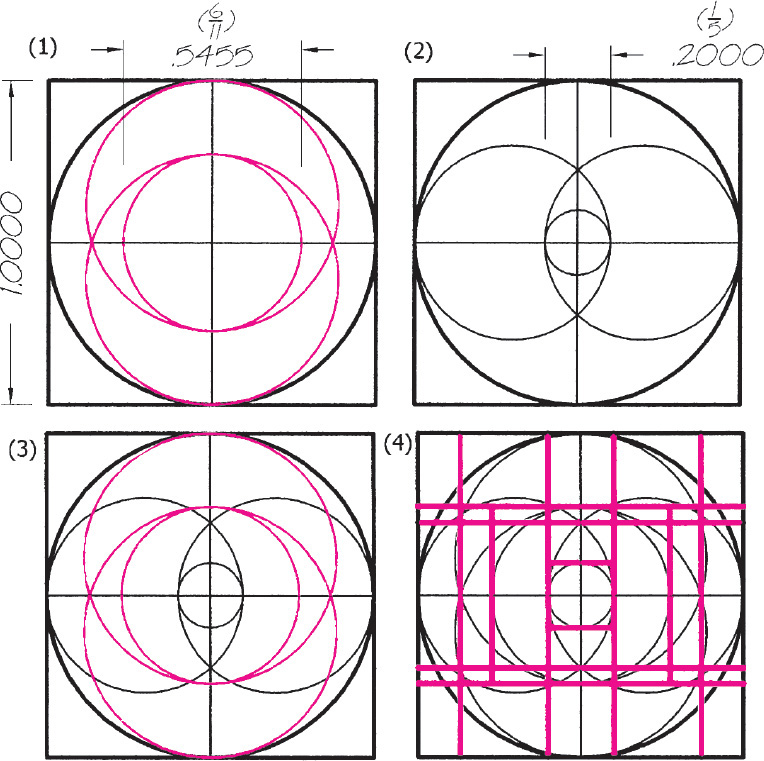
Drawing 9.5. Preliminary constructions for the Galactic Temple (see the Earth drawings in chapter 3). The three primary circles are established: those of the outer (1) and inner (2) cores within the containing circle representing both Earth and the galaxy. In (3) they are intersected, and in (4) lines are drawn inscribing circles and vesicas. Deletions and refinements result in drawing 9.6.
In chapter 3 we constructed the inner layers of the Earth. The inner core construction, generated from the just-sixth interval of 3/5 string length, results in an inner core of 1,584 miles in diameter, or 1/5 the diameter of Earth:
1/5 × 7,920 = 1,584.
The inner core is a sphere of solid iron and nickel of tremendous density and with a temperature equal to that at the surface of the Sun. Its diameter is in octave relation to the number of the Great Central Sun since
1,584 × 2 = 3,168.
The physical position of the inner core and its concentration of mass and high temperature at the center of Earth corresponds to the Great Central Sun at the center of the galaxy. Surrounding the inner core of Earth is the seething molten ring of the outer core with its diameter of 4,320 miles, equal to a double Moon diameter. The relation of diameters of outer core to inner core is
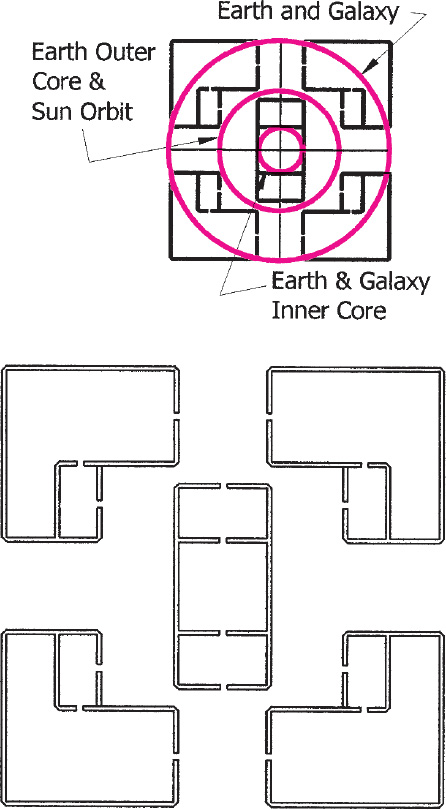
Drawing 9.6. The Galactic Temple. The ring shape of the inner Earth and its correspondence to the position of the solar system within the galaxy (top) produce this temple plan (bottom).
4,320/1,584 = 2.72 = 1/.3666,
a number we are familiar with—366 is the number of revolutions of Earth in one year and the number that relates the diameters of Earth (7,920) and Moon (2,160):
7,920/2,160 = 3.66.
It is interesting that the Great Central Sun number 3,168 is located within the Earth (in octave form) as 1,584, the inner core diameter. In the ancient geocentric view the Sun does indeed orbit around the core of Earth, around its internal Great Central Sun. (We can add that the inner core revolves in an easterly direction, and the outer core turns around it in a westerly direction.) Thus
3,168/864 = 792/216 =
Great Central Sun/Sun = Earth/Moon
= 1,584 (inner core) (× 10)/4,320 (outer core) = 3.66.
THE GALACTIC CORE
We have noted that the outer core of Earth has a diameter equal to a doubled Moon. If we consider Earth’s diameter equal to 1, then the outer core equals 2 × 3/11 (.272), or 6/11 of Earth’s diameter. If we expand Earth’s diameter so that it equals the diameter of the galaxy of 100,000 light-years (LY), then the outer core diameter would equal
100,000 LY × 6/11= 54,545 LY, with radius = 27,272 LY,
which is about the estimated distance from the Sun to the Galactic Center. So the circumference of Earth’s outer core corresponds to an orbit of the Sun around the Galactic Center—that is, the outer core is slowly rotating around the inner core, and this corresponds to the movement of a ring of stars, which includes our solar system, around the Galactic Center. The outer stars of the galaxy in increasingly less dense concentrations correspond to Earth’s mantle and crust, which also becomes less dense as its distance from the center increases.